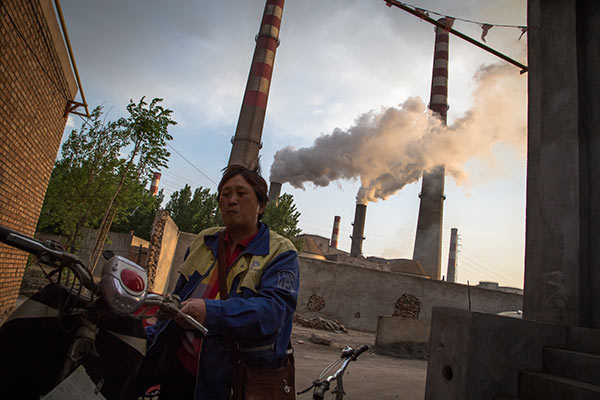
A resident reacts to the air in Handan, Hebei province, in April. The city, known for its highly polluting industries, such as steel, is facing an industrial transformation. File photo
(ECNS)-- A report released by China's Academy of Social Science (CASS) says Beijing is still receiving air pollutants from neighboring provinces, with Hebei the biggest source. It calls for collaborative efforts in the Beijing-Tianjin-Hebei region to tackle air pollution.
The report titled Green Book on Climate Change: Annual Report on Actions to Address Climate Change (2016) was released on Tuesday.
Citing figures from Beijing's environmental protection bureau, it says 28 to 36 percent of the PM2.5 detected in the capital during 2012 to 2013 was from input. In some cases, over half of pollutants in the capital was from neighboring areas.
Pan Jiahua, head of the Urban Development and Environment Research Institute under the CASS, said reliance on coal and heavy industries makes the Beijing-Tianjin-Hebei region a major producer of air pollutants.
The report also said the amount of sulfur dioxide and oxynitride discharged in the region make up 3.5 times and 4.3 times of the country's average level, respectively.
Cities in the area have started to work together in tackling air pollution. During the 2014 to 2015 period, the area had slashed capacity in polluting industries including iron and steel products by 42 million tons, cement by 50 million tons and panel glass by 29 million boxes.
But the effect still falls short. According to the Ministry of Environmental Protection, the number of days when the 13 cities in the Beijing-Tianjin-Hebei area recorded good air quality represents 60.8 percent of the first three quarters this year, while the figure was 74.5 percent for the 25 cities in the Yangtz River Delta area and 90.1 percent for the 9 cities in the Pearl River Delta area.
Among the top 10 cities with the worst air quality in the first three quarters, six were in Hebei, including Xingtai which topped the rank.
The report pointed out that the problem couldn't be sorted out by cities working alone. It requires collaborative and institutionalized efforts across the region.


















































